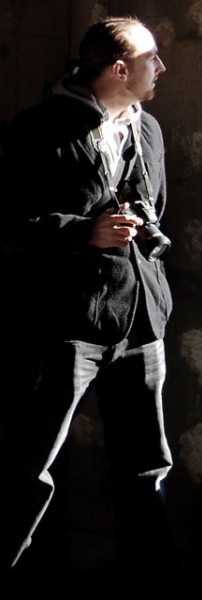 Today we have the pleasure of interviewing Michael John Grist, the author of Mr. Ruins and the Ruins War trilogy. He's also the author of the Ignifer Cycle, two anthologies, and Into the Ruins, an account of his travels through the modern ruins of Japan. His latest work is The Last, the story of a comic book artist in the zombie apocalypse.
Today we have the pleasure of interviewing Michael John Grist, the author of Mr. Ruins and the Ruins War trilogy. He's also the author of the Ignifer Cycle, two anthologies, and Into the Ruins, an account of his travels through the modern ruins of Japan. His latest work is The Last, the story of a comic book artist in the zombie apocalypse.
New Podler: Thanks for being here with us today, Michael!
Michael John Grist: Happy to be here, thanks for having me!
NP: I found out about you by accident. I was searching for something, and I was directed to the ruins exploration portion of your website. While there are some photos collected from around the internet, the photos from Japan are all yours. Can you tell us how that came about?
MJG: Sure, and it’s sort of by accident too. First off though, I was always into ruins. As a kid I’d explored some of the big abandoned factories near Manchester where I grew up—they were probably cotton mills—as well as taking adventures into whatever dilapidated farmhouses and industrial relics were left over near my house. My friends and I loved that kind of thing, inspired by The Goonies and Indiana Jones.
So I was predisposed towards liking ruins. In Japan I investigated a few when I came across them: a US military base that had been abandoned for 30 or so years, a block of flats left for 20. They were opportunistic explores, before I realized that going to ruins could be a hobby.
That realization came with reading an article about a handful of Japanese people who were going to these ruins, called ‘haikyo’, and writing books about them. They visited all kinds of places: ruined theme parks, factories, spas, ghost towns, etc. They had blogs and some of them had published books. Some of them provided maps. It captured my imagination, as ruins always had, and I started heading out to see the places for myself.
NP: What drew you in? What is it about these abandoned places that grabs your attention?
MJG: It’s a mixture of things, probably starting with the spirit of adventure. There’s a thrill to being in these places, and a special feeling to the sense of discovery as you wander through them. Few people get to experience that, I think, so I count myself lucky.
As I went to more and more ruins though, that sense of thrill was superseded by other feelings: awe at some of the grander ruins, like desolate shipyards from World War Two and theme parks, an ethereal sense of connection to the past in dusty old school-rooms in ghost towns shuttered for a generation, plus the creative challenge of trying to capture the beauty and appeal of these places in photographs.
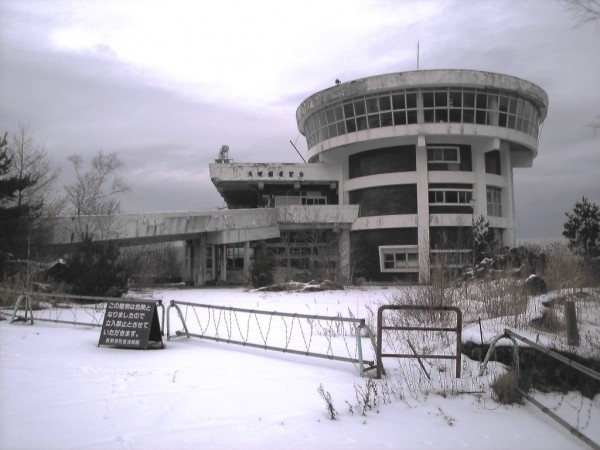
NP: I can't get over the fact that these places exist in Japan. I was under the impression that land was terribly scarce and nothing went to waste. Is there a common explanation for why these places were abandoned or is it random?
MJG: There is a common explanation, largely due to the economy but also historical reasons. Japan had a huge economic bubble in the 80s, but has been in a deflationary spiral ever since. In the boom days, all kinds of grand investments were made into resort hotels, theme parks, massive hotels and so on, typically far out in the mountainous countryside. The theme parks Sports World and Russian Village are great examples of this; large complexes that opened right around the bubble bursting.
Nobody went there and they went bust. After that these places became toxic assets to the bank, impossible to sell as they were deep in the red, so they just sat there.
Other reasons include the exhaustion of Japanese resources—leaving ghost towns in the mountains which were once thriving mining towns—or because of the war—leaving missile factories and bunkers lying in ruins on isolated coastlines.
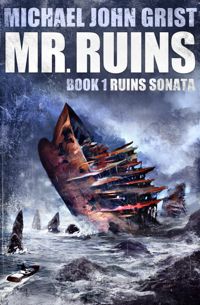 NP: Was your fascination with ruins the inspiration for writing the Ruins War?
NP: Was your fascination with ruins the inspiration for writing the Ruins War?
MJG: It definitely was. Around that time I stopped exploring ruins in the real world, feeling that I’d exhausted the stock of the country’s best ruins. I wanted to continue exploring still, so through a story seemed the natural extension. I needed bigger, grander ruins, in a new world, so I set the Ruins War world in a post-apocalyptic, tsunami-wrecked future, where massive clusters of wrecked ‘godships’ held all kinds of treasures, and there were shark-fighting arenas, and sunken ‘subglacics’- submarines designed to go under the Arctic ice.
NP: Despite the devastation wrought by the global tsunamis, humanity has rebuilt civilization behind walls, much like medieval castles, only far larger. During Ritry's time in Calico, he seems to have driven all his demons away. Whereas out on the skulks, the floating shanty towns outside the walls of Calico, he was always a total mess. And it seemed that just about everyone else he meets out there was as well. What do Calico and the skulks symbolize to you?
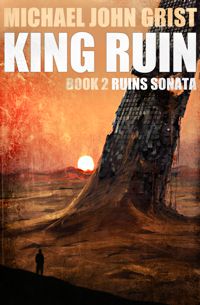 MJG: Well, for Ritry the skulks are a penance, and a purgatory. He survived awful things in the Arctic War, and he feels awful guilt to be the sole survivor of his crew. The War hurt him deeply, and he can’t really get over it. He needs time to heal, and the lawless panacea that the skulks provide- being able to throw himself into booze, violence, women, affords him that chance.
MJG: Well, for Ritry the skulks are a penance, and a purgatory. He survived awful things in the Arctic War, and he feels awful guilt to be the sole survivor of his crew. The War hurt him deeply, and he can’t really get over it. He needs time to heal, and the lawless panacea that the skulks provide- being able to throw himself into booze, violence, women, affords him that chance.
More broadly, the dichotomy between the skulks and Calico behind the wall represent a kind of dystopia/utopia situation. While there has been a terrible war, and civilization in many places has been completely destroyed, we’ve also evolved. Calico is a peaceful, beautiful city, because people have figured out how to make it that way. One way it’s done is to send, or allow, all the people who want a lawless, impermanent life to the skulks, where they can take their chances. Out there fortunes can be made and lives can be lost at the drop of a hat.
In Calico, there’s stability and progression. Maybe these are two aspects to human nature- the order of civilization versus the chaos of nature red in tooth and claw. Ritry’s movement between the two represents his personal evolution from a broken creature controlled by his wilder drives, to a thinking man in full control of his own nature.
NP: Ritry is a graysmith, a blacksmith for the mind. His occupation enables him to implant and delete memories. Where did you come up with the idea?
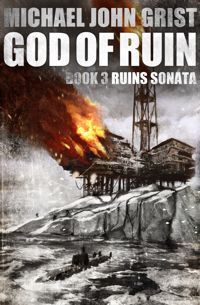 MJG: I was an English teacher in Japan, and in my earliest ideas, Ritry was a language teacher too. I expanded that role and made it more futuristic with the gray-smithing technology, kind of a Matrix or Johnny Mnemonic tech, and expanded the contents from only language to just about any knowledge or skill. It allowed for the depths of the mind to be plumbed.
MJG: I was an English teacher in Japan, and in my earliest ideas, Ritry was a language teacher too. I expanded that role and made it more futuristic with the gray-smithing technology, kind of a Matrix or Johnny Mnemonic tech, and expanded the contents from only language to just about any knowledge or skill. It allowed for the depths of the mind to be plumbed.
NP: But graysmithing is different than either of the mind experiences in those two stories. Both of them involve massive computer networks with constructed realities. Mr. Ruins does not. It's a far more personal experience.
MJG: That's true, it's definitely an organic, evolving experience in the Ruins War world. The secondary world isn't something built up by computers, it exists independently, though machines can be used to help gain access to that world. Part of the skill of being a graysmith is knowing how to use the machine tools necessary to hack through. Of course, the real skill then lies in being able to tailor every 'dive' into another mind so it is a personal experience, not a brute force assault.
NP: There's this theme running through the story that memory is malleable. Maybe fluid is more accurate a term. Was this a conscious decision?
MJG: Definitely. I think we’re on the verge of mastering our own programming as humans, whether that be our genetic code or the knowledge and memories in our heads, that make up our personalities. Granted, ‘on the verge’ may be still 50 or more years away in reality, but it’s so close we can almost reach out and touch it. And when we reach it, a lot of things will change.
It may lead to an answer to the tricky question of the soul. Is the soul real, and if so is it separate from our personalities? Should we consider it a third leg of the nature vs. nurture debate? If we can control for nature by changing genetics, control for nurture by reprogramming the brain, then will we become wholly different people, or will our souls keep us on track?
These questions were very much in my head as I wrote Mr. Ruins and the sequels.
NP: Your "aetheric bridge" reminded me of Emerson's "Over-Soul". Any connection?
MJG: I suppose so, though it wasn't something I had consciously in mind as I came up with the world and its rules. The idea of the 'Oversoul' makes a certain sweet sense to me—that all souls are connected, and the human self/ego is a kind of 'rider' atop the soul, or vice-versa. I really enjoyed writing the scene where Ritry tries to explain to the Don what the soul/aetheric bridge is, and likens each person to a radio that tunes into a bit of something like an 'Oversoul', with that particular bit of frequency comprising their soul, on loan to a human body.
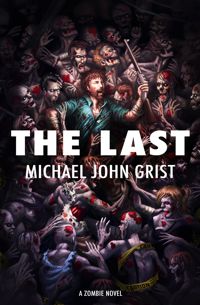 NP: You've recently released, The Last, the story of a comic book artist in the zombie apocalypse. What can you tell us about it?
NP: You've recently released, The Last, the story of a comic book artist in the zombie apocalypse. What can you tell us about it?
MJG: It's Robinson Crusoe meets the zombie apocalypse. One man alone survives infection, a sweet and non-violent comic-book artist called Amo (it means 'I love' in Latin). The sudden and total zombification of New York leaves him alone and stranded in an ocean of zombies. First he must survive. Second he must decide what survival even means if he's really the last? What kind of man should he be, and what kind of goals should he have, and most of all, is he truly the last man alive?
NP: Any plans to return to exploring ruins? I hear that Hashima (aka Gunkanjima "Battleship Island") is open to tours. Pripyat, perhaps?
MJG: I explored ruins in a kind of frenzy for about four years, then steadily slacked off. I'd been to pretty much all the major ruins locations in Japan by that time, which left only a lot of similar-looking places on a more minor scale. The number of abandoned hot springs hotels and apartments is immense, and I had no desire to see them all. I was satisfied.
The only really big one I hadn't been to was Hashima, but curiously enough I never felt very compelled to go there. I think that's because of things like the tours. Once a place goes as mainstream as that, it loses its 'explorer' thrill I guess. Even before the tours it was the most over-exposed ruin in Japan. Now I explore the ruins I invent, which can be just as uncharted and fresh as my imagination allows. That's plenty enough excitement for me.
NP: That's going to do it for me. If anyone in the audience has any questions for Michael, please post them in the comments.
Thanks again for joining us today, Michael.
TG: It was my pleasure, thanks again for having me.
NP: To learn more about the Ruins War trilogy, Michael's ruins travelogue, or his other works, please visit his website.
No comments:
Post a Comment